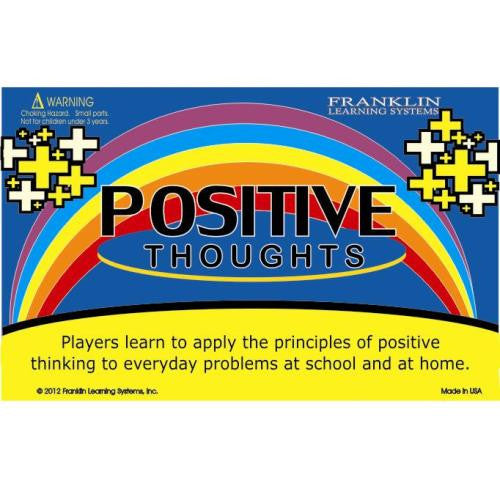Positive Thoughts
- In the heat of a problem, conflict, or disappointment, it is hard to get kids to think things through clearly
- Gives kids a way to learn these concepts and apply them in the game
- After learning both the pitfalls and the skills for dealing successfully with these problems, kids can apply the skills to their own issues
- Suitable for ages 7-11 years
Too often kids (and many adults too) react to a problem situation without taking the time to think in a clear and rational way. In the heat of a problem, conflict, or disappointment, it is hard to get kids to think things through clearly. They tend to blame others, blame themselves, be unnecessarily pessimistic, or insist on self-centered solutions.
The Positive Thoughts game gives kids a way to learn these concepts and apply them in the game - when they are not upset or under pressure. After learning both the pitfalls and the skills for dealing successfully with these problems, kids can apply the skills to their own issues. Positive Thoughts is based on the principles of cognitive therapy, and shows that many problems can often be traced to irrational thinking processes. Problems can be alleviated or solved by beginning to use rational thinking processes.
In the game, strategies are applied to everyday problems, not serious problems. The game uses the word "positive" instead of "rational," and "negative" instead of "irrational. The game makes the pitfalls easy to understand by representing them with animals: Blaming Bear, Downer Dragon, and My Way Moose. Players not only learn how to identify these examples of negative thinking, but also learn the positive way to deal with problems and avoid these thinking pitfalls. The three animals appear on a color sheet that should be put out during game play.
There are two sets of rules. Version A is designed for second and third graders. Version B, which is more challenging, is designed for fourth and fifth graders. First graders can use Version A if the teacher is present to help facilitate.
There are five decks of cards. The red and purple cards are What's the Problem Cards. They are usually examples of negative thinking. Players must say which thinking error is presented on the card - Blaming Bear, Downer Dragon, or My Way Moose. A few of the cards are not examples of negative thinking. For these cards the player says "positive thinking" or "no problem" in order to give a right answer. Yellow Plus or Minus Cards give examples of negative or positive thinking. Players gain points for the positive thinking examples and lose points for the negative thinking examples. The green You Decide Cards give situations that require positive thinking. The player must say how the situation could be handled in a way that shows positive thinking. The blue Multiple Choice Cards represent situations and three possible answers. The player must pick the best answer.
Players will:
1. learn to recognize typical negative thinking patterns;
2. learn that these negative thinking patterns usually lead to frustration and unhappiness;
3. learn positive thinking patterns and positive actions that they can take to deal with problems in an effective way; and
4. learn to recognize negative thinking patterns in their own behavior and change them into positive more effective patterns of thought and behavior.
Suitable for ages 7 thru 11
Publication Date: May 2012

